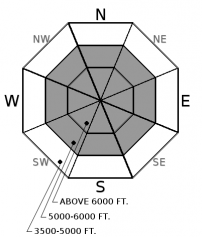| Friday | Friday Night | Saturday | |
|---|---|---|---|
| Cloud Cover: | Snow | Snow | Scattered snow showers ending mid-morning |
| Temperatures: | 33 to 38 deg. F. | 7 to 12 deg. F. | 25 to 30 deg. F. |
| Wind Direction: | W | NE | E |
| Wind Speed: | 15 to 20 mph, gusting 30 mph | 15 to 20 mph, gusting 25 mph | 10 to 15 mph, gusting 25 mph |
| Snowfall: | 2 to 4 in. | 1 to 3 in. | 0 in. |
| Snow Line: |
Whitefish Range
Swan Range
Flathead Range and Glacier National Park
How to read the forecast
The return of snow and wind may form thin slabs over a variety of snow surfaces. The danger is MODERATE but could rise to CONSIDERABLE by this afternoon. Evaluate snow totals and look for surface cracks as a sign of instability.

2. Moderate
?
Above 6500 ft.
2. Moderate
?
5000-6500 ft.
1. Low
?
3500-5000 ft.
- 1. Low
- 2. Moderate
- 3. Considerable
- 4. High
- 5. Extreme
-
Type ?
-
Aspect/Elevation ?

-
Likelihood ?CertainVery LikelyLikelyPossible
 Unlikely
Unlikely -
Size ?HistoricVery LargeLargeSmall

2-4” of snow fell overnight. Snowfall today may form shallow storm slabs at mid and upper elevations. Thin slabs will develop over a sun crust on sunny aspects and consolidated powder or wind-stiffened surfaces on shady aspects. Surface instabilities can be evaluated by monitoring snow totals and using hand pits or small test slopes to evaluate new snow bonding. As snow accumulates today or if snowfall rates increase, slabs will become more widespread and may increase in sensitivity to the weight of a skier or rider. Look for lens-shaped pillows and anticipate deeper drifts on leeward slopes from moderate winds and strong gusts. Cracks in the snow surface is a sign of instability and use caution around terrain traps.
Snowfall started overnight with 2-4” found throughout the forecast area. New snow is falling on a strong upper snowpack. Yesterday, observers found unreactive wind slabs (ob 1, ob 2) from strong winds earlier this week and a variety of surface conditions ranging from corn snow on sunny aspects to consolidated or wind-stiffened surfaces on shady aspects. Mountain temperatures dropped below freezing overnight, so anticipate sunny aspects now harboring a newly formed sun crust. This could act as a slippery bed surface for thin storm slabs. As snowfall continues today, monitor snow totals, and use hand pits or small test slopes to evaluate surface instabilities. A small slide around trees and cliffs could have a bad outcome.
An arctic cold front is forecasted to move westward over the Continental Divide this afternoon/ early evening colliding with warm, moist air out of the west. The verdict is still out on timing and location of the two air masses merging. Overall snowfall totals are dependent on the location of the frontal boundary so anticipate quickly changing conditions. Mountain locations closer to the divide are favored for deepest snowfall totals with lesser amounts further west and south. The danger could rise to CONSIDERABLE by this afternoon if snowfall rates increase or snow depths are higher than forecasted. Moderate west winds will shift to the northeast as the cold front moves overhead accompanied by strong gusts. Anticipate areas of deeper drifts to shift from typical to atypical slopes throughout the day.
If you use our advisories, we encourage you to offer us feedback on this 5-minute survey. For those who participate, we are raffling off a pair of Zeal goggles on April 5th. Thanks!
Strong west flow develops this morning through the afternoon with gusts approaching 50 mph at upper elevations. An arctic boundary is forecasted to move westward through NW Montana later this afternoon and evening shifting winds from west to northeast and lowering air temperatures. Exact timing and location of the two air masses colliding is up in the air with highest snow accumulations along the frontal boundary. We can anticipate 6-10" by midnight with locations closest to the Continental Divide favored receiving the deepest amounts.
This advisory applies only to backcountry areas outside established ski area boundaries. This advisory describes general avalanche conditions and local variations always occur. This advisory expires at midnight on the posted day unless otherwise noted. The information in this advisory is provided by the USDA Forest Service who is solely responsible for its content.
















